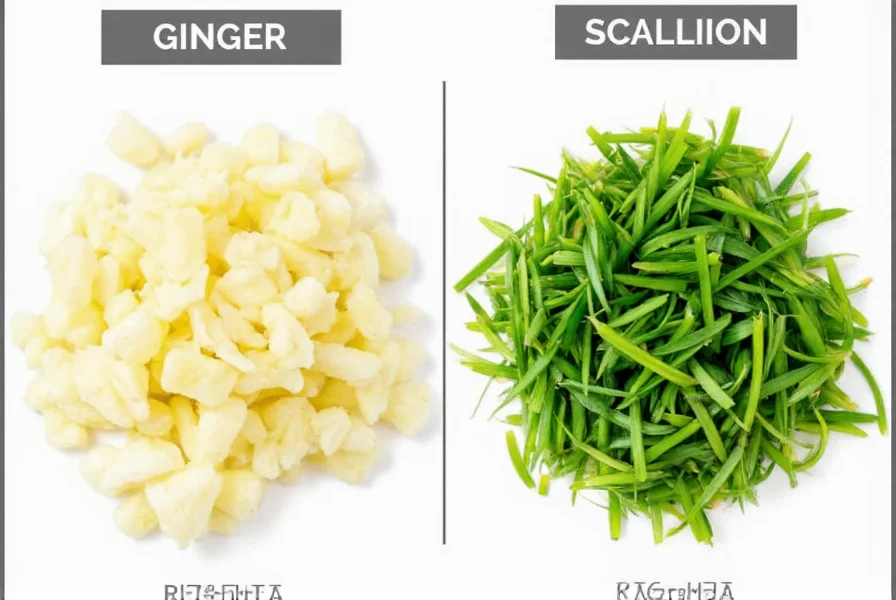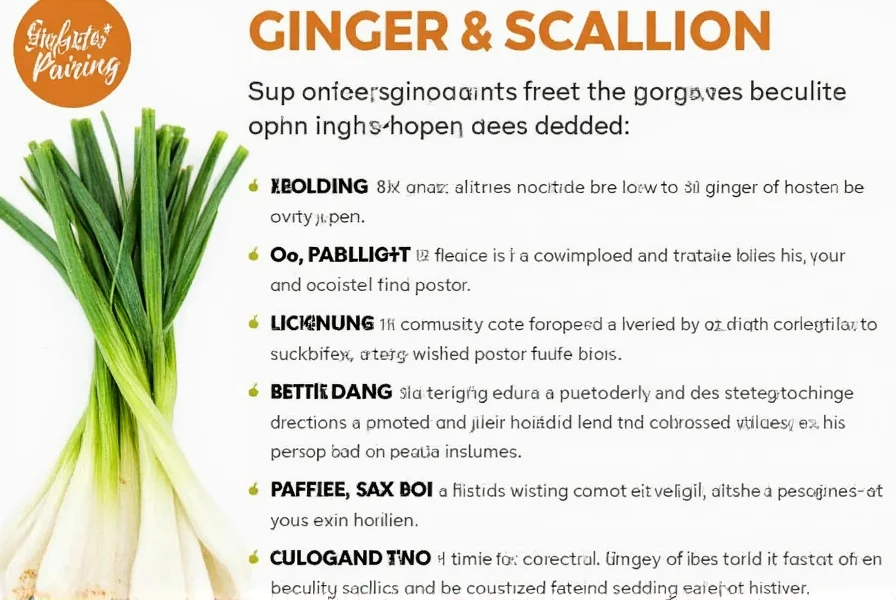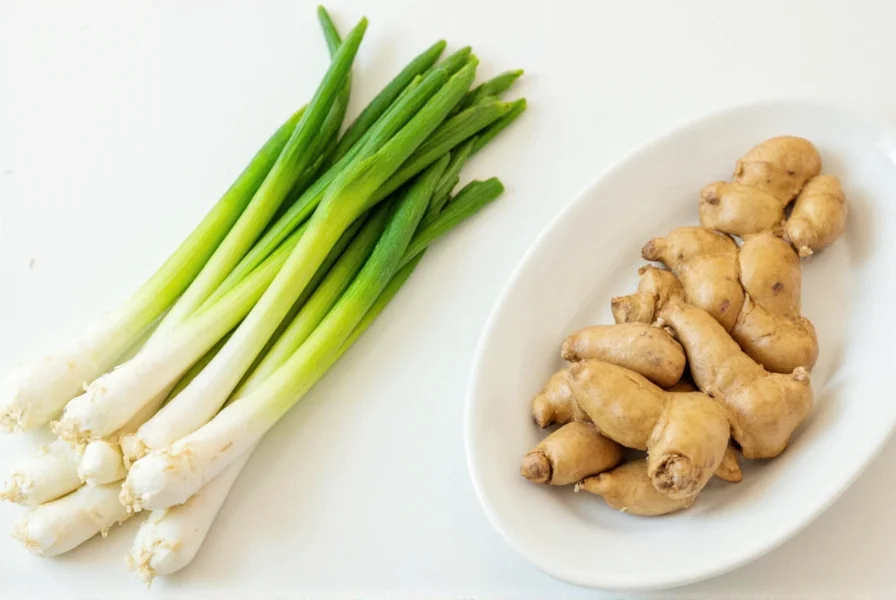Understanding the perfect synergy between ginger and scallion unlocks professional-level cooking techniques used across Chinese, Japanese, Korean, and Southeast Asian culinary traditions. This aromatic pairing works because ginger's zingy, slightly peppery warmth complements scallion's crisp freshness, creating a flavor foundation that builds depth without overwhelming other ingredients. Chefs worldwide rely on this combination as a starting point for countless dishes, from simple stir-fries to complex braises.
The Science Behind the Perfect Flavor Pairing
Ginger contains gingerol, a compound responsible for its characteristic warmth and slight heat, while scallions provide allicin and other sulfur compounds that deliver their distinctive fresh onion flavor. When combined, these ingredients create a balanced flavor profile where ginger's spiciness is tempered by scallion's mild sweetness. This complementary relationship allows both ingredients to enhance rather than compete with each other.
Professional chefs typically use young ginger (with thin skin and high moisture content) paired with fresh green scallions for the most vibrant flavor. The white portion of the scallion offers a stronger onion flavor that stands up well to high-heat cooking, while the green portion provides a milder, grassier note perfect for finishing dishes.
Essential Culinary Applications
Ginger and scallion form the aromatic base for numerous classic dishes across Asian cuisines. In Chinese cooking, this combination appears in:
| Dish Type | Application Method | Flavor Contribution |
|---|---|---|
| Stir-fries | Finely minced, added at beginning of cooking | Creates aromatic foundation that infuses entire dish |
| Steamed Fish | Sliced into thin matchsticks, placed under and over fish | Infuses delicate flavor while neutralizing fishiness |
| Noodle Dishes | Combined with oil to create aromatic base sauce | Provides signature flavor profile for dishes like dan dan noodles |
| Marinades | Grated ginger and chopped scallion blended with liquids | Penetrates proteins while adding complex flavor layers |
Mastering Preparation Techniques
Proper preparation makes all the difference when working with ginger and scallion. For ginger, use a spoon to easily peel the thin skin without removing excess flesh. Then, depending on the dish, you might:
- Julienne: For visible texture in stir-fries and as garnish
- Minced: For even flavor distribution in sauces and marinades
- Grated: For maximum flavor extraction in dressings and quick-cooking dishes
- Sliced: For steaming applications where you want distinct ginger pieces
For scallions, separate the white and green portions as they have different cooking properties. The white parts withstand higher heat and longer cooking times, while the green parts are best added toward the end of cooking or used raw as garnish.

Regional Variations Across Global Cuisines
While most prominent in Chinese cooking, the ginger-scallion combination appears in various forms worldwide:
- Japanese cuisine: Finely minced and used in ponzu sauce and as a garnish for grilled fish
- Korean cooking: Combined with garlic and sesame oil for marinades and dipping sauces
- Vietnamese dishes: Used in canh (soups) and as part of the flavor base for pho
- Caribbean cooking: Incorporated into jerk seasoning blends alongside allspice and Scotch bonnet peppers
Each culture adapts the ginger and scallion ratio to suit local preferences. Chinese cooking typically uses a 1:1 ratio by volume, while Japanese preparations might feature more scallion to ginger for a subtler flavor profile.
Perfecting Your Ginger Scallion Sauce
Creating an authentic ginger scallion sauce requires attention to ingredient quality and preparation:
- Use young ginger for its tender texture and less fibrous quality
- Peel ginger with a spoon to preserve maximum flesh
- Finely mince both ingredients using a sharp knife (avoid food processors which can make them mushy)
- Combine with neutral oil heated to just below smoking point
- Pour hot oil over the aromatics to release essential oils without burning
- Add salt to taste and let rest for 15 minutes before using
This simple sauce transforms steamed fish, roasted vegetables, or even plain rice into restaurant-quality dishes. For variation, add a splash of rice vinegar for brightness or a pinch of sugar to balance flavors.

Common Mistakes to Avoid
Many home cooks make these critical errors when working with ginger and scallion:
- Using dried or powdered ginger instead of fresh - loses the bright, complex flavor profile
- Burning the aromatics - ginger especially burns quickly at high heat, turning bitter
- Adding both ingredients at the same time - ginger typically needs slightly longer cooking than scallion
- Using old, dried-out ingredients - fresh ginger should be firm with smooth skin; scallions should be crisp with vibrant green tops
- Over-processing - finely mincing by hand preserves texture better than food processors
Storage and Selection Tips
Choosing and storing these ingredients properly extends their shelf life and preserves flavor:
- Ginger selection: Look for firm, smooth-skinned roots with no wrinkles or soft spots
- Ginger storage: Store unpeeled in a paper bag in the refrigerator crisper drawer for up to 3 weeks
- Scallion selection: Choose bundles with crisp, bright green tops and firm white bases
- Scallion storage: Trim roots, wrap in damp paper towel, and store in airtight container for 5-7 days
- Freezing option: Finely mince both ingredients and freeze in oil in ice cube trays for ready-to-use portions
Conclusion
The ginger and scallion combination represents culinary harmony at its finest—a pairing that elevates dishes without dominating them. By understanding the proper preparation techniques, regional applications, and flavor chemistry behind this classic duo, home cooks can significantly elevate their cooking. Whether you're preparing a simple weeknight stir-fry or an elaborate feast, mastering this fundamental flavor foundation will transform your dishes with professional results.
Frequently Asked Questions
What's the ideal ratio of ginger to scallion in cooking?
The classic ratio is 1:1 by volume for most Chinese dishes, though this varies by cuisine. For delicate preparations like steamed fish, use slightly more scallion to ginger (2:1). For heartier stir-fries, equal parts works best. Always adjust to personal preference as freshness of ingredients affects potency.
Can I substitute regular onions for scallions with ginger?
While possible, regular onions create a different flavor profile. Scallions provide a more delicate, fresh onion flavor that complements ginger's warmth without overpowering it. If substituting, use only the white part of leeks or shallots, which offer a closer flavor match to scallions when paired with ginger.
How long does homemade ginger scallion sauce last?
Properly stored in an airtight container in the refrigerator, ginger scallion sauce maintains peak flavor for 3-4 days. The oil helps preserve the aromatics, but for best results, use within 72 hours. You can extend shelf life by freezing portions in ice cube trays, then transferring to freezer bags for up to 3 months.
Why does my ginger and scallion sauce taste bitter?
Bitterness typically comes from burning the aromatics. Ginger burns quickly at high temperatures, turning bitter. To prevent this, heat oil to just below smoking point (around 350°F/175°C), then immediately remove from heat before pouring over the ginger and scallion. The residual heat will properly infuse the oil without burning the ingredients.











 浙公网安备
33010002000092号
浙公网安备
33010002000092号 浙B2-20120091-4
浙B2-20120091-4